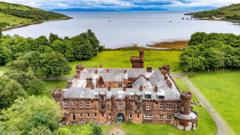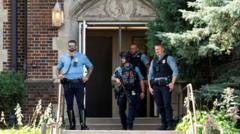Could You Own a Scottish Island Castle for £750,000?

Published: 2025-08-27 13:35:19 | Category: technology
The historic Kinloch Castle, located on the Isle of Rum, is back on the market after a previous sale fell through due to disagreements between a businessman and a Scottish government minister. Owned by NatureScot, this Victorian-era hunting lodge, currently listed for offers over £750,000, is in need of significant repairs. Community involvement and sustainable development are central to the discussions surrounding its potential sale.
Last updated: 15 October 2023 (BST)
Key Takeaways
- Kinloch Castle is for sale with a starting price of £750,000.
- The property is currently in a poor state and requires significant restoration.
- Community involvement in the future of the castle is a key requirement from local residents.
- Previous plans for the castle included converting it into a hostel or museum.
- The sale has been complicated by political disagreements and community concerns.
Background of Kinloch Castle
Kinloch Castle was constructed between 1897 and 1900 by George Bullough, an industrialist from Lancashire. This architectural gem, designed by the notable firm Leeming and Leeming, served as a luxurious hunting lodge, reflecting the opulence of the Victorian era. However, after World War I, the castle began to decline, leading to its acquisition by the Nature Conservancy Council in 1957, which is now known as NatureScot.
Recent Sale Attempts and Controversies
In 2021, businessman Jeremy Hosking made headlines with his bid to purchase Kinloch Castle. His plans included restoring the property to its former glory. However, in March 2023, Hosking withdrew his offer, citing a breakdown in communications with Lorna Slater, who was the biodiversity minister at the time. Slater had intervened in the sale following concerns raised by the Isle of Rum Community Trust regarding the lack of transparency in Hosking's proposed plans for the castle.
Community Concerns and Government Intervention
The Isle of Rum, home to around 40 residents, has a strong sense of community, which plays a crucial role in discussions surrounding the castle's future. The community trust expressed worries about the implications of a private sale, advocating instead for greater local involvement in the property's management. This led to the Scottish government emphasising the importance of community consultation in determining the castle's fate.
Current Listing and Expectations
Now back on the market, Kinloch Castle is being offered for sale with expectations that prospective buyers will outline their plans for the property, particularly how they intend to contribute to the local community and environment. Chris Donald from NatureScot has highlighted that potential buyers should demonstrate a commitment to sustainability and cultural heritage as part of their bids.
Community Feedback and Research Findings
Research conducted by the Scottish government's Rural and Environment Science and Analytical Services (RESAS) revealed that a majority of islanders believe the castle should be sold and redeveloped. They propose that any new owner should actively engage with the community and adhere to land access rights. While most residents favour a sale, a minority prefer transferring the castle into community ownership or allowing it to remain in managed decline.
Historical Significance and Future Prospects
The potential restoration of Kinloch Castle is seen not only as a chance to revive an important piece of Scottish heritage but also as an opportunity to support the local economy through tourism. Previous redevelopment proposals included transforming it into a 41-bedroom hostel or a museum and visitor attraction, which could significantly benefit the island's economy.
Challenges Ahead
Despite the castle's historical significance, its current state of disrepair poses considerable challenges for any prospective buyer. Extensive restoration work is needed, which raises concerns about the financial viability of such projects. Additionally, the involvement of local communities and government bodies adds a layer of complexity to any sale process.
The Way Forward for Kinloch Castle
As the sale progresses, the emphasis on community involvement and sustainable development remains paramount. The future of Kinloch Castle will depend on finding the right buyer who aligns with the community's vision for the property. NatureScot's commitment to keeping island residents informed throughout the process is a positive step towards ensuring transparency and fostering local trust.
Conclusion
The story of Kinloch Castle illustrates the delicate balance between private ownership and community interests in the context of historical preservation. As it returns to the market, the hope is that the next chapter for this iconic structure will not only honour its rich history but also contribute positively to the Isle of Rum and its residents. What innovative ideas will prospective buyers bring to restore and enhance this landmark?
#KinlochCastle #IsleOfRum #ScottishHeritage
FAQs
What is the current asking price for Kinloch Castle?
The current asking price for Kinloch Castle is offers over £750,000. This reflects the property's historical value and the significant restoration work required.
Who owns Kinloch Castle?
Kinloch Castle is owned by NatureScot, a Scottish government agency responsible for managing natural heritage sites in Scotland.
What plans were proposed for Kinloch Castle in the past?
Previous proposals for Kinloch Castle included converting it into a 41-bedroom hostel or establishing a museum and visitor attraction, highlighting its potential for tourism.
What are the community's concerns regarding the sale?
The community has raised concerns about the lack of transparency in previous sale attempts and emphasised the need for local involvement and adherence to land access rights.
Why did Jeremy Hosking withdraw his bid for the castle?
Jeremy Hosking withdrew his bid citing a lack of communication from government officials, which he felt hindered his plans for the castle's restoration.



